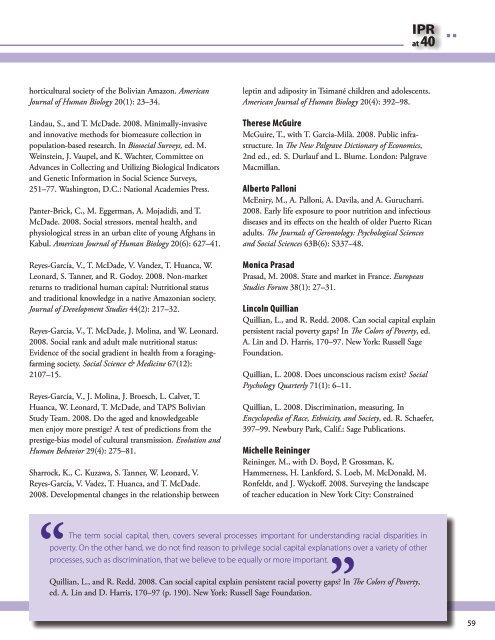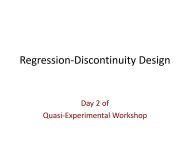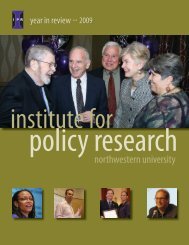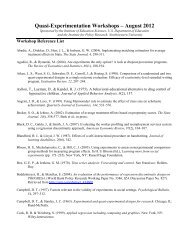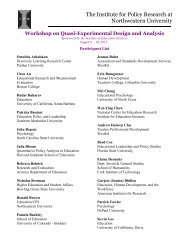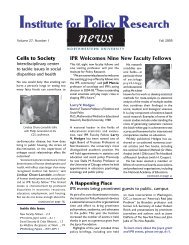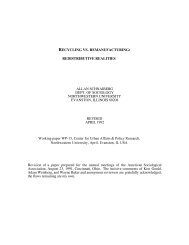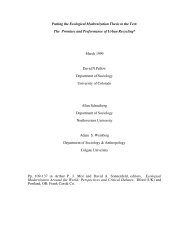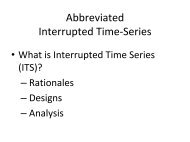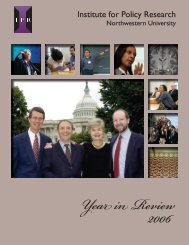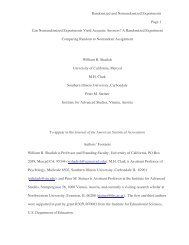IPR - Institute for Policy Research - Northwestern University
IPR - Institute for Policy Research - Northwestern University
IPR - Institute for Policy Research - Northwestern University
Create successful ePaper yourself
Turn your PDF publications into a flip-book with our unique Google optimized e-Paper software.
<strong>IPR</strong><br />
at 40<br />
horticultural society of the Bolivian Amazon. American<br />
Journal of Human Biology 20(1): 23–34.<br />
Lindau, S., and T. McDade. 2008. Minimally-invasive<br />
and innovative methods <strong>for</strong> biomeasure collection in<br />
population-based research. In Biosocial Surveys, ed. M.<br />
Weinstein, J. Vaupel, and K. Wachter, Committee on<br />
Advances in Collecting and Utilizing Biological Indicators<br />
and Genetic In<strong>for</strong>mation in Social Science Surveys,<br />
251–77. Washington, D.C.: National Academies Press.<br />
Panter-Brick, C., M. Eggerman, A. Mojadidi, and T.<br />
McDade. 2008. Social stressors, mental health, and<br />
physiological stress in an urban elite of young Afghans in<br />
Kabul. American Journal of Human Biology 20(6): 627–41.<br />
Reyes-García, V., T. McDade, V. Vandez, T. Huanca, W.<br />
Leonard, S. Tanner, and R. Godoy. 2008. Non-market<br />
returns to traditional human capital: Nutritional status<br />
and traditional knowledge in a native Amazonian society.<br />
Journal of Development Studies 44(2): 217–32.<br />
Reyes-Garcia, V., T. McDade, J. Molina, and W. Leonard.<br />
2008. Social rank and adult male nutritional status:<br />
Evidence of the social gradient in health from a <strong>for</strong>agingfarming<br />
society. Social Science & Medicine 67(12):<br />
2107–15.<br />
Reyes-García, V., J. Molina, J. Broesch, L. Calvet, T.<br />
Huanca, W. Leonard, T. McDade, and TAPS Bolivian<br />
Study Team. 2008. Do the aged and knowledgeable<br />
men enjoy more prestige? A test of predictions from the<br />
prestige-bias model of cultural transmission. Evolution and<br />
Human Behavior 29(4): 275–81.<br />
Sharrock, K., C. Kuzawa, S. Tanner, W. Leonard, V.<br />
Reyes-García, V. Vadez, T. Huanca, and T. McDade.<br />
2008. Developmental changes in the relationship between<br />
leptin and adiposity in Tsimané children and adolescents.<br />
American Journal of Human Biology 20(4): 392–98.<br />
Therese McGuire<br />
McGuire, T., with T. Garcia-Milà. 2008. Public infrastructure.<br />
In The New Palgrave Dictionary of Economics,<br />
2nd ed., ed. S. Durlauf and L. Blume. London: Palgrave<br />
Macmillan.<br />
Alberto Palloni<br />
McEniry, M., A. Palloni, A. Davila, and A. Gurucharri.<br />
2008. Early life exposure to poor nutrition and infectious<br />
diseases and its effects on the health of older Puerto Rican<br />
adults. The Journals of Gerontology: Psychological Sciences<br />
and Social Sciences 63B(6): S337–48.<br />
Monica Prasad<br />
Prasad, M. 2008. State and market in France. European<br />
Studies Forum 38(1): 27–31.<br />
Lincoln Quillian<br />
Quillian, L., and R. Redd. 2008. Can social capital explain<br />
persistent racial poverty gaps? In The Colors of Poverty, ed.<br />
A. Lin and D. Harris, 170–97. New York: Russell Sage<br />
Foundation.<br />
Quillian, L. 2008. Does unconscious racism exist? Social<br />
Psychology Quarterly 71(1): 6–11.<br />
Quillian, L. 2008. Discrimination, measuring. In<br />
Encyclopedia of Race, Ethnicity, and Society, ed. R. Schaefer,<br />
397–99. Newbury Park, Calif.: Sage Publications.<br />
Michelle Reininger<br />
Reininger, M., with D. Boyd, P. Grossman, K.<br />
Hammerness, H. Lank<strong>for</strong>d, S. Loeb, M. McDonald, M.<br />
Ronfeldt, and J. Wyckoff. 2008. Surveying the landscape<br />
of teacher education in New York City: Constrained<br />
“<br />
The term social capital, then, covers several processes important <strong>for</strong> understanding racial disparities in<br />
poverty. On the other hand, we do not find reason to privilege social capital explanations over a variety of other<br />
processes, such as discrimination, that we believe to be equally or more important.<br />
”<br />
Quillian, L., and R. Redd. 2008. Can social capital explain persistent racial poverty gaps? In The Colors of Poverty,<br />
ed. A. Lin and D. Harris, 170–97 (p. 190). New York: Russell Sage Foundation.<br />
59


